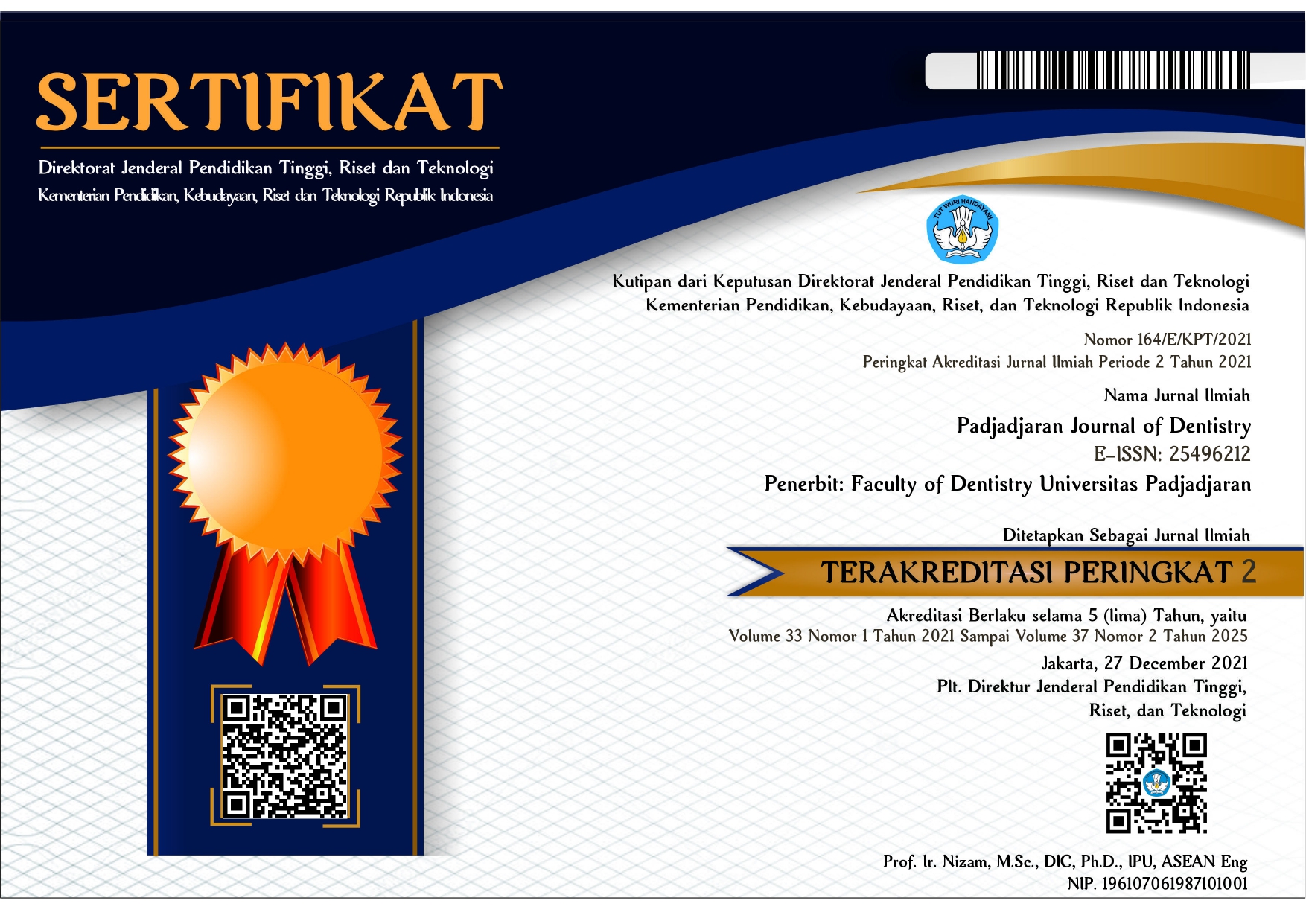Flexural strength comparison of self-synthesised porcelain with the sintering temperature of 1150 degree Celsius and 1200 degree Celsius
Abstract
Introduction: Porcelain must have sufficient flexural strength to withstand mastication forces. The flexural strength of porcelain can be influenced by the maturity level of porcelain related to the temperature and sintering time. The purpose of this study was to compare the flexural strength of Indonesian natural sand self-synthesised porcelain with different sintering temperatures. Methods: Self-synthesised porcelain powder, with the composition of 65% Pangaribuan felspar, 25% Belitung silica, 5% Sukabumi kaolin, and 5% potassium salt, were condensed into 10 samples with the size of 7cm x 2cm x 0.4cm. A total of 5 samples were each burned at the temperature of 1150°C and 1200°C. Flexural strength test was performed using the Universal Testing Machine (Netzsch™) with the lowest load of 7.5 kg, and the data obtained was calculated using the bending strength formula. Result: The average flexural strength of self-synthesised porcelain at the sintering temperature of 1150°C was 26.678 MPa, while at the temperature of 1200°C was 39.038 MPa. Conclusion: This study concluded that Indonesian natural sand self-synthesised porcelain had a lower flexural strength at the sintering temperature of 1150°C than at the temperature of 1200°C.
Keywords: Flexural strength, self-synthesised porcelain, sintering temperature.
Full Text:
PDFReferences
Al-Makramani BM, Razak AA, Abu-Hassan MI. Biaxial flexural strength of Turkom-Cera core compared to two other all-ceramic systems. J Appl Oral Sci. 2010; 18(6): 607-12. DOI: 10.1590/S1678-77572010000600012
Gozneli R, Kazazoglu E, Ozkan Y. Flexural properties of leucite and lithium disilicate ceramic materials after repeated firings. J Dent Sci. 2013; 9(2): 144-50. DOI: 10.1016/j.jds.2013.02.019
Julien KC, Buschang PH, Throckmorton GS, Dechow PC. Normal masticatory performance in young adults and children. Arch Oral Biol. 1996; 41(1): 69-75. DOI: 10.1016/0003-9969(95)00098-4
Junpoom P, Kukiattrakoon B, Hengtrakool C. Flexural strength of fluorapatite-leucite and fluorapatite porcelains exposed to erosive agents in cyclic immersion. J Appl Oral Sci. 2011; 19(2): 1-10. DOI: 10.1590/S1678-77572011000200003
Sakaguchi RL, Powers JM. Craig’s Restorative Dental Materials. 13th ed. St. Louis: Mosby-Elsevier; 2013. p. 253-76.
Helvey GA. Classification of dental ceramics. Inside Continuing Education. 2013; 13: 62-8.
Gunawan J. Sintesis dan uji kekuatan lentur porselen berbahan baku pasir alam campuran dari Pulau Sumatera dan Jawa [minor thesis]. Bandung: Universitas Padjadjaran; 2017. p. 40-60.
Boch P, Niepce JC. Ceramic materials. Processes, properties, and applications. 2nd ed. London: Hermes Science Publishing Ltd.; 2007. p. 130-55.
Carter CB, Norton MG. Ceramic materials. Science and engineering. 1st ed. New York: Springer-Verlag; 2007. p. 365-80.
Fischer J, Stawarczyk B, Hämmerle CH. Flexural strength of veneering ceramics for zirconia. J Dent. 2008; 36(5): 316–21. DOI: 10.1016/j.jdent.2008.01.017
Katz S. 1988. Translucent dental porcelain composition, its preparation and a restoration made thereof. EP0272745A2.
Kitouni S, Harabi A. Sintering and mechanical properties of porcelains prepared from algerian raw materials. Cerâmica. 2011; 57(344): 453-60. DOI: 10.1590/S0366-69132011000400013
Rahaman MN. Ceramic processing. 1st ed. Boca Raton: CRC Press; 2007. p. 365-81.
DOI: https://doi.org/10.24198/pjd.vol30no3.19307
Refbacks
- There are currently no refbacks.
 All publications by the Universitas Padjadjaran [e-ISSN: 2549-6212, p-ISSN: 1979-0201] are licensed under a Creative Commons Attribution-ShareAlike 4.0 International License.
All publications by the Universitas Padjadjaran [e-ISSN: 2549-6212, p-ISSN: 1979-0201] are licensed under a Creative Commons Attribution-ShareAlike 4.0 International License.





.png)
